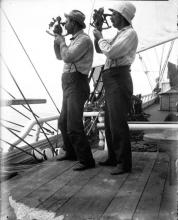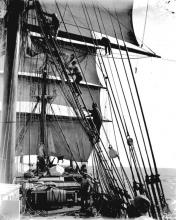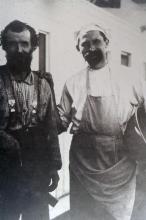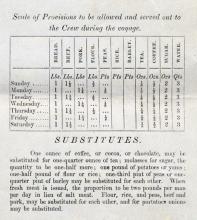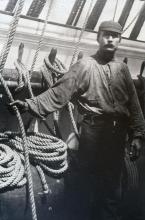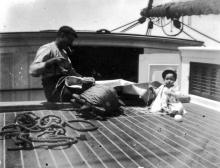The Crew
Crew size depended on the size and rig of the ship. A two-masted schoonerSchooner
A sailing vessel of two or more masts, all fore-and-aft rigged. The Thomas W. Lawson, built in 1902, had seven masts. In comparison to a square-rigged vessel of comparable tonnage, a schooner is better for coastwise sailing. might have a crew of five, while a clipper shipsClipper ship
Fast, narrow-hulled sailing ship with tall masts, many sails, and large crews. Built and used primarily in the mid-19th century. might carry eighty to a hundred men. A four-masted schooner at the end of the nineteenth century had a crew of about eleven; a Down EasterDown Easter downeaster; down-easter
Merchant sailing ship developed in Maine in the 19th century and designed for maximum carrying capacity with minimal crew size.
Read more had a crew of twenty to thirty.
Officers
The first mateFirst mate first officer
An officer on a merchant vessel, next in command to the captain., or chief mate, supervised day-to-day ship operations. At sea, he was in charge of one watchWatch
A portion of the ship's crew on duty at a given time to run the vessel., had general charge of the ship if the captain was below, kept the logbookLog logbook
1. Short for logbook, a document required to be kept by merchant and naval vessels. In the log must be recorded specific information relating to the navigation of the ship, the organization of her crew, and other activities on board.
Read More, and took navigational sightsSun sights
Altitude observations of the Sun needed for celestial navigation. Sights is generally referred to taking a sun sight, but means also taking star sights at night. with the captain. In port, he supervised loading and unloading, while the captain took care of the business of the ship. If something happened to the captain, the first mate took over.
The second mateSecond mate
The officer third in command aboard a merchant vessel, after the captain and first mate. was in charge of half of the crew. He was typically promoted from among the able-bodied seamanAble-bodied seaman
One who performs all regular and emergency duties required in the deck department of a merchant ship.
Read More. As an experienced hand, he led the rest of the seamen in the work of running the ship, especially furlingFurl
To take in the sails of a vessel and secure them with gaskets. In the case of square-rigged ships, to haul in on the clew-lines and buntlines and roll sails up to the yards. In the case of fore-and-aft rigs, to lower and secure sails to the boom or stays. sails and working in the riggingRig
The general term describing the characteristics of masts and sails that determine the type of sailing vessel.
Read More.
As an officer, he oversaw the seamen who steered the ship on his watch. The second mate also managed food supplies and checked on the condition of stored food.
Skilled Trades
A cookCook
The person whose occupation is to prepare food for others. was indispensable—popular if good, not so if bad! The cook baked bread and made meals for the captain’s cabin and for the crew. He had a long day of work, so did not stand watches. On fishing schooners, the cook was sometimes second in importance only to the captain.
On larger ships, the cook reported to the stewardSteward
The person aboard ship in charge of provisions and aiding the cook., who was the captain’s servant and kept the captain’s cabin clean. If the captain’s wife was aboard, there might be a stewardess, possibly the steward’s wife. In the deep sea trades, many stewards were from ChinaChina
During the period of the China Trade, when Mainers were sailing to ports in China, the Qing (or Ch'ing) Dynasty (1644-1911) was in power. The Qing Dynasty was established by the Manchus in northeastern China, and expanded to surrounding territories of Inner Asia, establishing the Empire of the Great Qing.Read more. or another Far Eastern country.
Seamen
SeamenSeaman
A sailor or mariner. Any person employed or engaged aboard ship, with the exception of the master, pilot, or apprentice. operated and maintained the ship. Those signing on for the first or second time were ordinary seamen, and those with more experience were able-bodied seamen. Maine’s maritime communities often supplied crew for schooners carrying Maine cargoes to other East Coast ports.
Bigger ships, sailing from cities such as New York, had crews from all over the world, including northern Europe, the West Indies, and China. By the late nineteenth century, it was sometimes difficult to find a good crew. Life at sea was hard, and often there were easier and better-paying jobs available ashore.
On larger ships, the boatswain (pronounced bos’n) was in charge of maintenance. Under direct supervision by the first mate, the boatswainBoatswain bos'n, bosun
Pronounced bo'son, the leading petty officer of the deck crew of a merchant ship, in charge of equipment and the crew. kept an eye on the condition of the hullHull
The main body of a ship, not including masts, rigging, and internal fittings. The hull consists of the upper deck, sides, and bottom. and the rigging. He led work such as painting; repairing, replacing, or splicingSplice
The method of joining tow ropes or wires together by unlaying the strands at the two ends and tucking or relaying them according to the nature of the splice required. lines; making sure shacklesShackle shackles
A bow-shaped or U-shaped steel or iron fitting with a pin across the throat end, used as a connection between lengths of chain or to attach other fittings. Shackles used in the rigging have a threaded pin, and those used for joining lengths of anchor chain have a smooth heavy pin. were in good shape; and maintaining mechanical equipment such as the capstanCapstan
A machine used on board ship to provide mechanical power to raise the anchor, hoist yards, or lift heavy weights. The capstan consists of a cast-steel barrel mounted on a vertical spindle and smallest in diameter around the middle, to allow for the rope to wind up or down as the capstan is turned. At the top of the barrel, capstan bars are fitted into slots (pigeon holes) to allow sailors to turn the capstan.. He also kept track of maintenance supplies in the bos’n’s lockerBoatswain's Locker bos'n's locker
Also Bos'n's Locker. A small compartment for tools and materials for repairing or making up rigging or cargo gear..
Some larger square-riggedSquare-rigged
The arrangement of sails in a vessel where the main driving sails are laced to yards lying square to the mast. It is the oldest type of known rig. Such a vessel is called a square rigger. vessels carried a carpenterCarpenter ship's carpenter
In merchant sailing days, a petty officer responsible for maintenance of all the ship's boats, spars, masts, hull, and fixed rigging; also responsible for plugging any shot holes with special wooden plugs. The ship's carpenter is often nicknamed "Chips." A carpenter or ship's carpenter can work in a shipyard also, building vessels. who was in charge of maintaining all wooden structures, including the ship’s boats. Some also had a sailmaker. Sails often required repairs, and sometimes the crew, under the sailmaker'sSailmaker
One who makes and assembles canvas articles used on ships and boats, such as sails, awnings, and covers.Read more. direction, made new sails from canvas carried aboard. A square-rigger usually had two “suits” of sails: an older one used in light winds and a newer one used for heavy weather sailing.
Carpenters and sailmakers were considered idlersIdlers idler
On a merchant ship, those crew members who do not stand a regular watch., as they did not stand regular watches, and they lived aft with the mates, steward, and boysBoy
Youngster serving on a merchant or fishing vessel in order to acquire the necessary training to become a sailor..
At the age of sixteen, a young man could sign on as a boy. Like midshipmenMidshipman
A naval officer trainee; the lowest rank of an officer, midshipmen take their name from their stations amidships on a sailing warship.Read more. in the Navy, boys had some advantages and often were friends of the captain or the owners. They learned the basics of operating the ship and navigation. Some boys went on to become captains; some never went to sea again. Edwin Mitchell, a 16 year old from Belfast, took one voyage to California and back in 1866-67, then never went to sea again. He went on to make his living selling eggs. Read his journal in the Special Features section of this web site.

